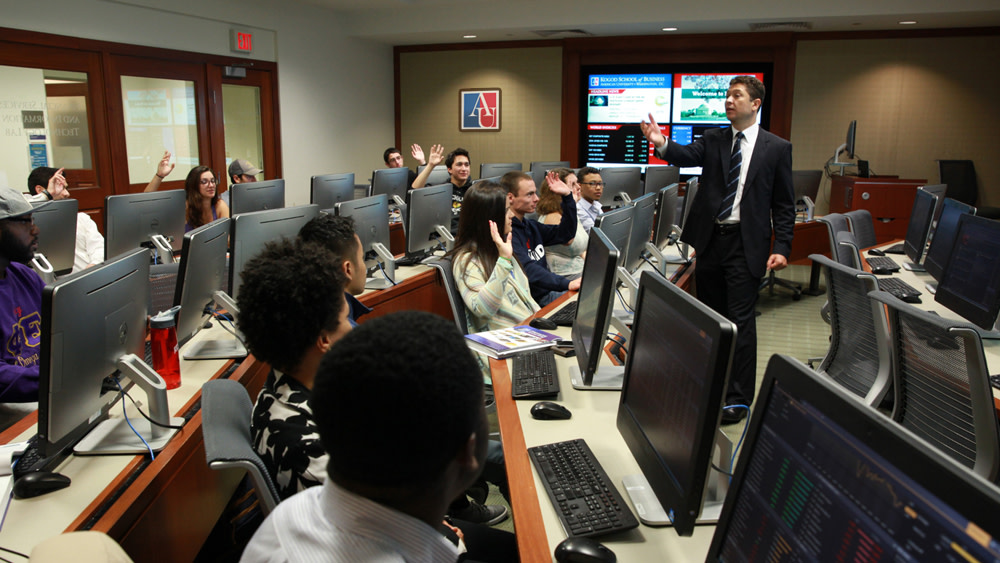When you think of Washington, DC, you may think of history, politics, and international affairs. While those fields are well represented throughout the region, the US capital is also home to renowned public and private organizations in science, technology, engineering, and math (STEM) sectors, including NASA, the National Institutes of Health (NIH), and numerous non-governmental organizations (NGOs).
American University’s expanded STEM-eligible degrees for undergraduate students provide the skills and real-world work opportunities that help you stand out to employers — and qualify you for the Optional Practical Training (OPT) extension available to STEM degree earners.
STEM Degree Programs at American University
American University’s STEM-designated bachelor’s degree programs include biology, chemistry, computer science, data science, engineering, environmental science, game design, mathematics and statistics, neuroscience, and physics.
Sharmeen Ahsan-Bracciale, managing director, American University International Accelerator, says that data science is a particularly popular degree.
“Nationally and internationally, there is a big demand for data science,” she explains. “It is a program that is very suited for international students. Unlike many policy-based programs, the concepts are universal; they are not specific to a region or country.”
Ahsan-Bracciale also cites the investment American University is making in STEM degrees, particularly the Hall of Science facility, a recent addition to campus. Since scientists must work across disciplines to solve today’s biggest challenges, the 125,000-square-foot space is designed to encourage this interdisciplinary interaction.
As part of the International Accelerator at American University, you’ll not only get more support with language and academic help, but your advisors can also guide you with your major selection so you take the right prerequisite courses and electives. This means that the classes you take in year one set you up for success in years two, three, and four, ensuring you take all the classes you need to finish your undergraduate degree in four years.
Washington, DC: A Top Location for STEM Degree Earners
Ranked second in the nation for STEM jobs by Forbes, Washington, DC, is more than a hub of international and domestic politics and policy. The capital of the United States is home to leading public and private sector organizations like Amazon, Danaher Corporation, IBM, Lockheed Martin, and the National Institute of Standards and Technology (NIST).
In fact, American University’s College of Arts and Sciences faculty have secured grants from organizations including NASA, NIH, and the National Science Foundation. This has more than doubled their research funding over the past few years.
“DC is the center of many things,” says Ahsan-Bracciale. “There are a lot of opportunities for students to get real-world experience.” Students can pursue internships, with many options also offering the chance to earn course credits.
Having so many top employers nearby also means American University is able to attract impressive faculty who have real-world experience and know the most up-to-date trends in their fields. “It also gives students an opportunity to make connections, which can lead to internships, which in turn can lead to employment opportunities,” Ahsan-Bracciale adds.
Experiential Learning, Research, and Internship Opportunities
Experiential learning, or learning by doing, is deeply incorporated into STEM-designated programs at American University. For students interested in research, there are plenty of opportunities to connect with faculty on research projects. Undergraduates make up 60% of students conducting research in labs.
On campus, students can also use the Design and Build Lab (DaBL), a digital fabrication, rapid prototyping, and experimentation space in the Don Myers Technology and Innovation Building. The space allows students to test theories and answer complex questions by creating real models and product prototypes.
For internships, the Washington, DC, area has a range of prestigious research centers, including NIH, the Food and Drug Administration (FDA), and NIST, as well as private organizations including Adobe, Booz Allen Hamilton, and RK&K.
“NIH is right in our backyard,” Ahsan-Bracciale notes. She also points out the number of organizations that have a presence both in DC and internationally, such as the Red Cross and the World Health Organization.
Undergraduate students can also participate in the Cohort-based Integrated Research Community for Undergraduate Innovation and Trailblazing (CIRCUIT) program. Run by the Johns Hopkins Applied Physics Laboratory (APL) in partnership with American University, CIRCUIT is a year-long research experience that empowers students with the skills needed to make significant contributions to science.
STEM Clubs at American University
Your coursework inside the classroom is just one part of your education at American University. The school offers more than 200 clubs, including STEM clubs, that bring together students who share similar interests.
Organizations include BRAIN (Being Really Awesome in Neuroscience), Women in Science, Association for Computing Machinery, Sustainable Ocean Alliance, and Underrepresented Students in STEM, to name just a few.
You can also mentor high school seniors from nearby McKinley Technology High School on their senior capstone project. This gives you an opportunity to hone your communication skills, including how you communicate about scientific knowledge in a way that others can easily understand.
STEM Student Outcomes
International students in a STEM-designated degree program have the option to extend their Optional Practical Training (OPT). OPT allows students to work for up to 12 months, while students in STEM fields can extend the training 24 months for a total of 36 months of OPT.
As Ahsan-Bracciale points out, employers are more excited to hire and invest in students who have three years’ eligibility to work in the US.
“Three years is a pretty solid tenure in any job,” she says. “Students not only get a great education, but they also get work experience and can bring back that knowledge of how US organizations operate to their home countries.”
American University balances the practical with the theoretical, preparing students for a wide range of jobs in academic as well as the public and private sectors. For example, computer science students go on to pursue careers that include software development and design, multimedia computing, artificial intelligence and computer vision, and other technical computing professions.
Area employers include the aforementioned NIH, NIST, and NASA, as well as Center for Sleep & Wake Disorders, Institute for Science and International Security, National Wildlife Federation, Pew Research Center, and the Walter Reed Army Institute of Research, among so many others.
Six months after graduation, 90% of American University undergraduate students from the Colleges of Arts and Sciences are either employed or in graduate school (or both). Top graduate schools include George Washington University, Columbia University, Harvard University, and more.
If you are considering pursuing a STEM degree, American University is one of the top places to do it, both for top-tier academics and its proximity to some of the leading organizations who have a need for graduates from STEM-designated fields.
“There is this perception that DC equals politics, but there is a lot more to DC,” stresses Ahsan-Barcciale. “There are high-caliber scientific organizations that have a presence here and internationally.”
What better place is there to launch your career?
Pursue a world-class STEM degree at American University >

